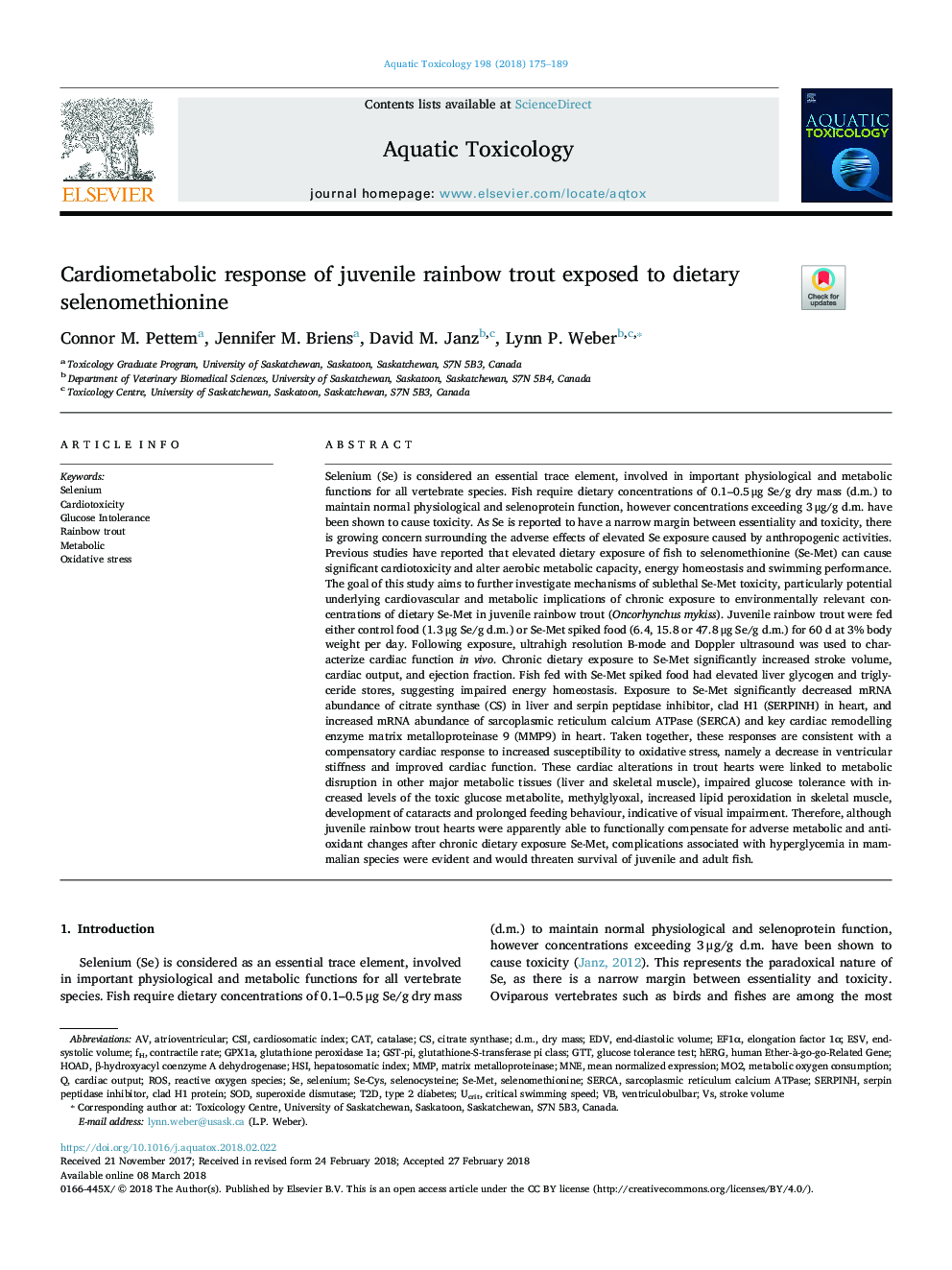| Article ID | Journal | Published Year | Pages | File Type |
|---|---|---|---|---|
| 8883791 | Aquatic Toxicology | 2018 | 15 Pages |
Abstract
Selenium (Se) is considered an essential trace element, involved in important physiological and metabolic functions for all vertebrate species. Fish require dietary concentrations of 0.1-0.5â¯Î¼g Se/g dry mass (d.m.) to maintain normal physiological and selenoprotein function, however concentrations exceeding 3â¯Î¼g/g d.m. have been shown to cause toxicity. As Se is reported to have a narrow margin between essentiality and toxicity, there is growing concern surrounding the adverse effects of elevated Se exposure caused by anthropogenic activities. Previous studies have reported that elevated dietary exposure of fish to selenomethionine (Se-Met) can cause significant cardiotoxicity and alter aerobic metabolic capacity, energy homeostasis and swimming performance. The goal of this study aims to further investigate mechanisms of sublethal Se-Met toxicity, particularly potential underlying cardiovascular and metabolic implications of chronic exposure to environmentally relevant concentrations of dietary Se-Met in juvenile rainbow trout (Oncorhynchus mykiss). Juvenile rainbow trout were fed either control food (1.3â¯Î¼g Se/g d.m.) or Se-Met spiked food (6.4, 15.8 or 47.8â¯Î¼g Se/g d.m.) for 60 d at 3% body weight per day. Following exposure, ultrahigh resolution B-mode and Doppler ultrasound was used to characterize cardiac function in vivo. Chronic dietary exposure to Se-Met significantly increased stroke volume, cardiac output, and ejection fraction. Fish fed with Se-Met spiked food had elevated liver glycogen and triglyceride stores, suggesting impaired energy homeostasis. Exposure to Se-Met significantly decreased mRNA abundance of citrate synthase (CS) in liver and serpin peptidase inhibitor, clad H1 (SERPINH) in heart, and increased mRNA abundance of sarcoplasmic reticulum calcium ATPase (SERCA) and key cardiac remodelling enzyme matrix metalloproteinase 9 (MMP9) in heart. Taken together, these responses are consistent with a compensatory cardiac response to increased susceptibility to oxidative stress, namely a decrease in ventricular stiffness and improved cardiac function. These cardiac alterations in trout hearts were linked to metabolic disruption in other major metabolic tissues (liver and skeletal muscle), impaired glucose tolerance with increased levels of the toxic glucose metabolite, methylglyoxal, increased lipid peroxidation in skeletal muscle, development of cataracts and prolonged feeding behaviour, indicative of visual impairment. Therefore, although juvenile rainbow trout hearts were apparently able to functionally compensate for adverse metabolic and anti-oxidant changes after chronic dietary exposure Se-Met, complications associated with hyperglycemia in mammalian species were evident and would threaten survival of juvenile and adult fish.
Keywords
MO2HOADSe-Metd.m.sarcoplasmic reticulum calcium ATPaseUcritEDVGST-piT2DHERGGTTCSIHSIMNEMMPESVCATEF1αROSCardiac outputglucose tolerance testOxidative stressdry massEnd-diastolic volumeend-systolic volumestroke volumeAtrioventricularType 2 diabetesSODCritical swimming speedSelenomethionineSelenocysteineSeleniumCardiotoxicitySuperoxide dismutaseCitrate synthaseHepatosomatic indexelongation factor 1αGlucose intoleranceRainbow troutSERCAmatrix metalloproteinaseMetabolichuman ether-à-go-go-related geneCatalaseReactive oxygen species
Related Topics
Life Sciences
Agricultural and Biological Sciences
Aquatic Science
Authors
Connor M. Pettem, Jennifer M. Briens, David M. Janz, Lynn P. Weber,
